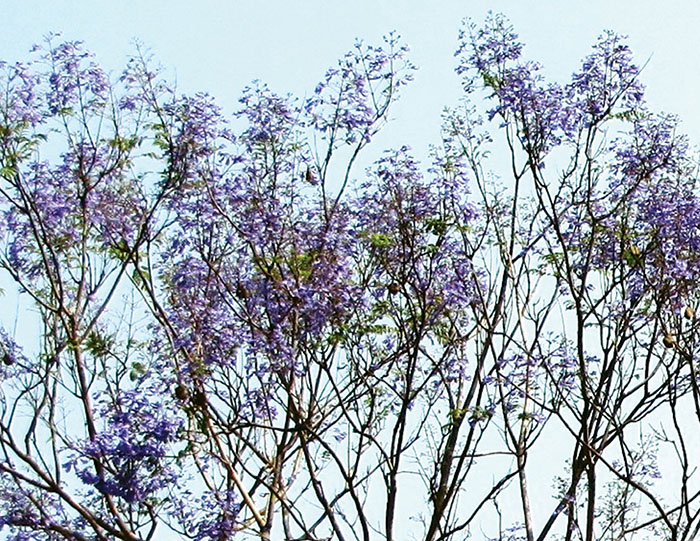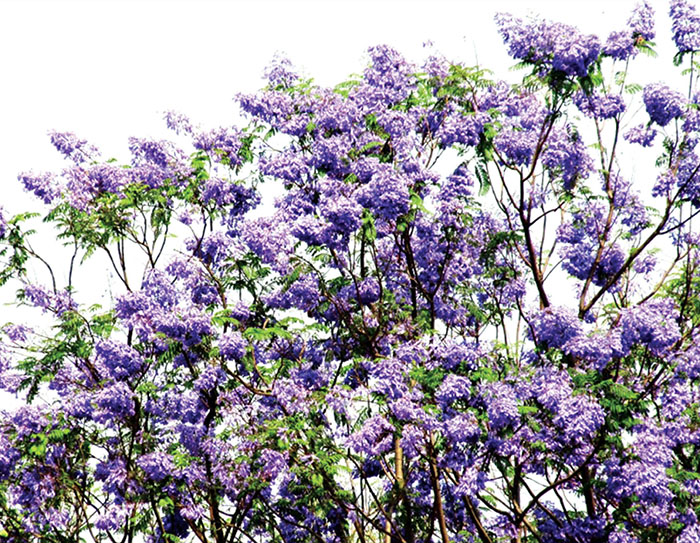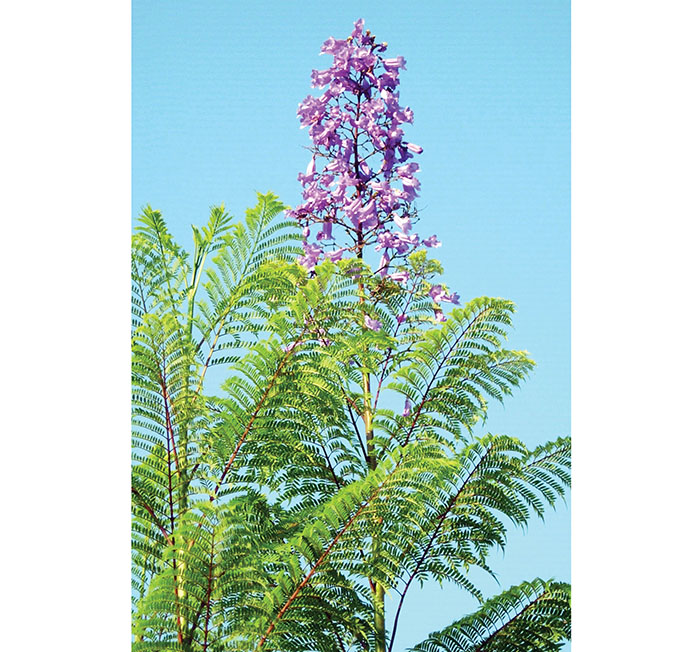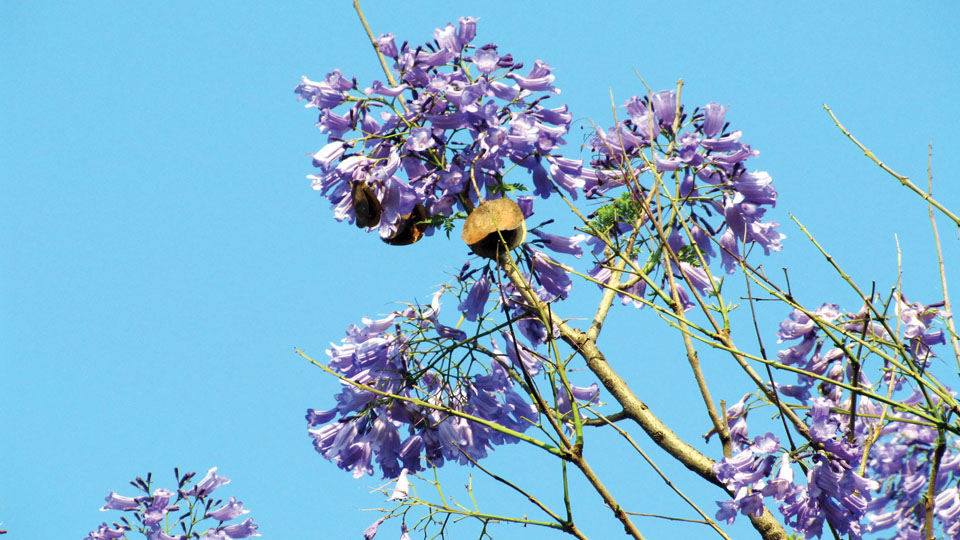Text & photographs by Dr. Mahadeswara Swamy, Scientist
End of Shishir Ritu (winter) brings about remarkable changes in many deciduous trees. Several species would have shed all their leaves to begin the rejuvenation process: the new cycle of life by producing fresh foliage & flowers. Several of these trees begin new life by producing new blossoms on bare branches.
Among these, Jacaranda is the first to appear on stage by initiating blooms, which, in a short time, cover the entire canopy making it the most attractive tree. These trees covered with clusters of trumpet-shaped fragrant, purple blooms often with fallen flowers forming a carpet under the tree makes the sight a painter’s delight. None can match the grandeur of Jacaranda!
The tree has been a part of Mysore’s landscape for decades. A South America beauty, it is native to Southern Bolivia and Argentina but widely cultivated in the tropics. It is known by common names such as Blue Jacaranda, Brazilian Rose Wood, Trumpet Tree, Black Poui, Nili Gulmohar, Green Ebony. The botanical name is Jacaranda mimosifolia (Bignoniaceae family). The generic name ‘Jacaranda’ is the Neo-Latin version of the word ‘jakara’na’, a word in Guarani language spoken by native South American ‘Tupi’ community, meaning ‘fragrant’, ‘aromatic’, ‘scented’. It aptly describes the aromatic flowering of the Blue Jacaranda. The specific name ‘mimosifolia’ is due to its resemblance to leaves of Mimosa (Touch Me Not).
It is a medium sized open crowned deciduous tree, very graceful to look at. The twigs are slender and slightly zigzag and light reddish-brown in colour. The mature bark is thin and grey-brown; smooth when the tree is young; eventually turns into a fissured and cracked bark. Wood scented. The leaves alternate, twice feathered, finely cut and fernlike with numerous pairs of tiny pointed leaflets. They resemble Gulmohar leaves. The flowers tubular (bell shaped), lavender or purple blue, in open clusters at the end of the branches. They fade in to lilac later. Each spray (bunch) carries up to 90 blossoms. The individual flower is about 2” long; Calyx (sepals) 5 lobes, united; Corolla (petals) lobes 5; 4 fertile stamens, dydynamous (2+2) and 1 sterile club shaped “staminode” bearing a dense tuft of bristles; Ovary bicarpellary; Fruit, a dry dehiscent pod, brown, technically called a capsule spontaneously opens into two halves on drying and releases winged seeds. Capsules may hang on the tree for up to 2 years.

General and medicinal uses
Many look at this tree simply for its ornamental and aesthetic value in landscaping. In reality, it has immense commercial value. The highly valued wood, which is scented & ornamentally streaked (cream and pink toned wood) is commercially known as ‘Pallisandre.’ The wood, with a pleasant smell, is used in carpentry for cabinet making and in automotive industry for luxury cars.
Medicinal values are immense. In its nativity Jacarandas are used in tribal medicine and historically been used on E-coli as well as Staphylococcus aureus or staph bacteria and found to be effective in the treatment of venereal diseases (syphilis and gonorrhea).
Application of Jacaranda extract on syphilitic sores helps them heal fast besides controlling the painful urination accompanied by pus in gonorrhoea patients. The volatile oil obtained from Jacaranda leaves and bark has been found to be effective in the treatment of buboes (swelling in the lymph nodes in groin or underarm characterized by blisters) caused by venereal diseases. The lovely fragrance of Jacaranda flowers are said to work “extra-medicinally” & turn the negative qualities in a person to positive ones. It has been reported that homoeopathy has myriad preparations of Jacaranda. Now, Jacarandas are reported to be used even in Ayurveda and Unani formulations.

Useful tips
- It is one of the loveliest garden trees with foliage and flowers having their own charm.
- Excellent tree for avenues and parks. Plant them in groups or in a continuous stretch on avenues.
- Propagation: By seeds. Dry the pods in the hot sun. Then pour cold water & cover them with a lid. Seeds come out with a splutter. Soak the seeds in water overnight before sowing them in seed beds or container. They germinate easily.
- Plants propagate easily in the sandy soil. Hence, it is better to mix an extra dose of sand in the growth media.
- The young saplings need staking to make them grow straight till they attain a good height.
- The tree is fast growing and re-sprouts easily if damaged.
- In order to give the best shape to show off the blooms, smaller branches should be trimmed before flowering.
- Though the tree has been introduced to India decades back it has not been exploited commercially for its wood and herbal medicines. There is a great scope for its proper utilisation by the concerned sectors.

Where to see
One can have a magnificent look of these trees with full violet blooms at the main entrance to palace (Eastern gate). Lining behind the fort these trees provide a colourful background to gopuras. Also seen on several avenues, private gardens, parks and Manasagangothri campus as well.
Mob: 97429-91057 / e-mail: [email protected]








“Medicinal values are immense. In its nativity Jacarandas are used in tribal medicine and historically been used on E-coli as well as Staphylococcus aureus or staph bacteria and found to be effective in the treatment of venereal diseases (syphilis and gonorrhea).
Application of Jacaranda extract on syphilitic sores helps them heal fast besides controlling the painful urination accompanied by pus in gonorrhoea patients. The volatile oil obtained from Jacaranda leaves and bark has been found to be effective in the treatment of buboes (swelling in the lymph nodes in groin or underarm characterized by blisters) caused by venereal diseases.”
“One can have a magnificent look of these trees with full violet blooms at the main entrance to palace (Eastern gate”
Interesting article. I have seen the tree mentioned above ,during my visit to Mysore and to the Palace, standing near the Palace gate mentioned above, and wondered where this tree came from?
Reading about its medicinal properties, one wonders whether the Wadiyars, their close circles of assistants and advisers, had a hand in importing the seeds of these trees from South America, during the decades gone by to help with their ailments! One hears about the colourful stories of them!! Glad to know, these Maharajas were not saints!!